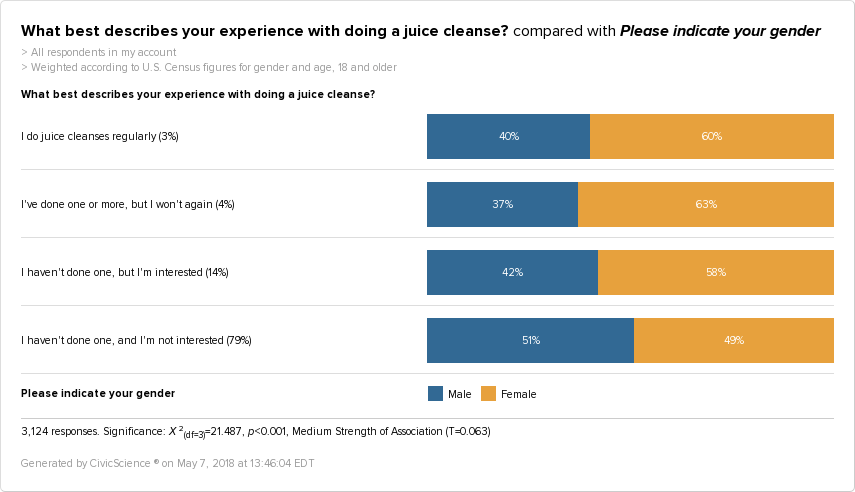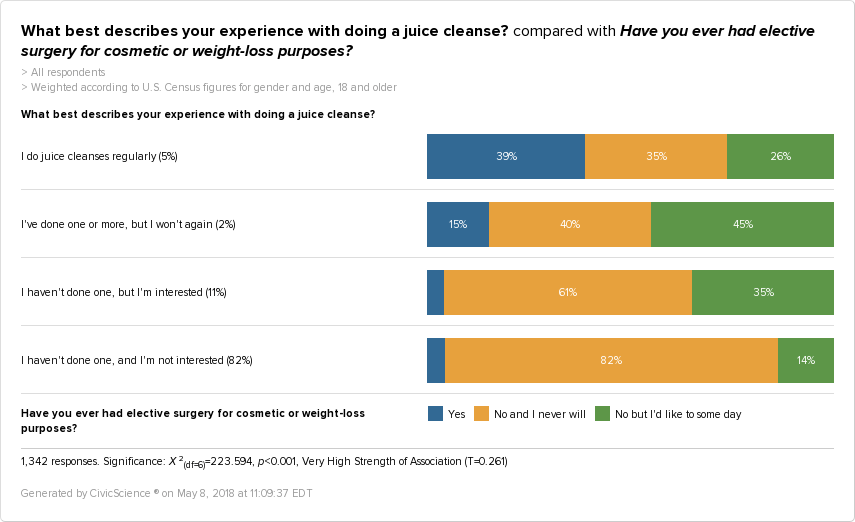The Gist: Price is the main inhibitor for individuals interested in trying a juice cleanse. However, for loyal juice cleansers, the benefits of the cleanse may have less to do with health and more to do with image.
It’s spring, which means that many people in the Northern Hemisphere will be taking off their winter coats for the first time in months, and looking for ways to feel better in their newly coat-less bodies. Lately, a series of cleanses have swept through the health world as a fast and convenient way to transition into the warmer seasons. Of the many options that exist, juice cleanses have long-standing acclaim.
So we wondered, who is doing juice cleanses these days? And could their popularity (or lack thereof) be linked to any other influences? Let’s dive in.
In our first question, we asked responders to tell us about their juice cleanse experiences. While most people have never done a juice cleanse and do not plan on it, the next largest group comes from those who haven’t done a cleanse, but who are interested. Right from the start, we can see that people are either very not interested or nurturing a budding interest in the juice cleanse scene. Who knew that juice cleanses could be so polarizing?
 As our data shows, women are more likely to be the group with an interest in juice cleanses. Take a look at what we found, below.
As our data shows, women are more likely to be the group with an interest in juice cleanses. Take a look at what we found, below.
While women make up 58% of those who would like to try a juice cleanse, they also make up 63% of those who have done one, but won’t do it again. Could juice cleanse expectations and experience be two very different things? That could be a possibility, especially given the fact that only 3% of US adults do juice cleanses regularly. Clearly, this activity appeals to a very specific crowd.
So who are these regular juice cleansers, how are they different from those who haven’t done one, but are interested, and what could be getting in the way of more US adults jumping on the juice cleanse bandwagon? Let’s find out.
Given the elite price tag attached to most cleanses, we started with a look at income.
Of those who juice regularly, 49% make more than $100,000 a year, confirming the notion that juice cleanses are far from affordable for the average US adult. That said, 35% who regularly cleanse make less than $50,000 a year.
US adults in the interested group, though they hail from all financial backgrounds, primarily make less than $50,000 a year. This small but solid contingent of interest, combined with the regular cleansers who also make less than $50k a year, could be enough to encourage companies to take price into consideration when seeking to attract new clientele.
Often, juice cleanses are considered an activity for health-minded folks. Would our data prove that to be the case?
Not exactly.
34% of those who have never participated in a cleanse and have no desire to do so actually think they are healthy eaters. While those who perceive their eating to be healthy do exist in the other categories, the largest group of healthy eaters has little interest in the juice cleanse world.
This graph provides other useful information, such as the fact that of those who have not done a juice cleanse, but would like to do so, 34% cite cost as the main inhibitor to healthy eating. And, in an unexpected twist, 44% of regular juice cleansers say they do not eat healthy because they don’t have time, or it’s too much work.
For this group, the ease of reaching into the fridge and grabbing the next bottle of juice is something they can commit to. But, could toting that bottle of juice during the day be more about carrying the juice to create a certain (high-income level) image, than drinking the juice to experience health benefits? We won’t judge, but the data could indicate that this is the case.
So, while high price could prevent some from trying a juice cleanse, and lack of time could encourage others to jump on board, the connection of juice cleanses to health may not be as strong as we might assume.
We took a further look in the direction of health, to see what might come up. And we found that there are also some interesting distinctions between juice cleansers and non-juice cleansers, when it comes to visiting the doctor.
53% of those who have not yet done a cleanse, but would like to, report going to the doctor 1-2 times a year. Across most categories, it seems that the cadence of 1-2 times a year is relatively common. However, when we look at the regular juice cleanser category, we see that 39% go 3-5 times a year, while 26% do not go at all. While many factors influence whether or not a person visits the doctor, it is interesting to note that doing a cleanse regularly could coincide with changes in seeking the advice of medical professionals.
What the above question does not specify, however, is what kind of health professional an individual may be visiting.
Just out of curiosity, we compared the juice cleanse question to a question regarding experience with elective cosmetic or weight-loss surgery.
As we can see, 39% of regular juice cleansers have had elective surgery for aesthetic or weight-loss purposes, while 35% of those interested in juice cleanses have not had a cosmetic or weight loss surgery, but would like to one day. This, combined with the fact that Millennials–who have recently been linked to preferring photoshopped advertising–comprise 56% of regular juice cleansers, we can’t help but wonder if the juice cleanse may be more about image than health, after all?
While price is one factor that can inhibit interested individuals from trying out a juice cleanse, for those who are committed, the benefits may be less about adopting a healthy lifestyle and more about looking the part.













